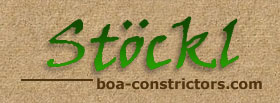How often should the snake be fed?
There is no general answer for this question. As mentioned previously, neonates must not be fed more often than once every 10 to 14 days (must, not should!).
Once they have passed their first year, it is certainly recommendable for the larger subspecies (Boa c. constrictor, Boa c. occidentalis) to feed on a weekly basis for a year. The growth rate is at its peak in this second year, and everything that the snake receives now, is converted into lengthwise growth.
Especially young Boa c. Constrictor turn hereby into real garbage disposals. As much as they can pose problems concerning regurgitation in their first year, they prove to be just as robust in their second year.
Naturally, Boa constrictors need to get used to a larger amount of prey slowly. Feeding a single mouse every 14 days in December, and then suddenly a breeder-sized rat every week in January is impossible. Therefore, increase slowly!
As soon as the boa has reached a satisfactory size or has put on a bit too much fat, the feeding intervals need to be increased again.
The following is valid as a rule of thumb for the entire remaining life-span of the snake: adult (mature) females are to be fed every 2 to 3 weeks, adult males every 3 to 4 weeks.
Once you are the proud owner of a three-meter „mallet“, feeding a guinea-pig or a young rabbit once every four weeks is satisfactory. Boa constrictors of that size (only the previously mentioned subspecies can reach this size) generally grow very slowly, and have a tendency to put on fat.
Boa force-feeding
If a newborn Boa constrictor neonate still stubbornly rejects prey even weeks after the first shed, and is in a condition that allows no further waiting, it is time to force-feed the snake.
For this purpose, you kill a prey animal of according size (pinkie mouse), and use egg white to reduce the friction. Next, take the freshly-killed rodent horizontally with a pair of tweezers in a manner that the arms of the tweezers do not reach beyond the head of the pinkie mouse. Then, push the prey into the mouth of the snake, until it cannot be seen anymore. In most cases by far, this activates the swallowing refelx of the young snake, and the further transport of the rodent to the stomach is done automatically. If this is not the case, you may massage the rodent carefully towards the midbody of the snake, until it reaches its final destiny.
information on boa feeding | feeding tips | Boa constrictor frozen rats | boa constrictor frozen mice | snake vitamins | boa proper feeding | boa feeding frequency | boa proper prey item size | Boa force feeding | boa feeder rats| boa feeder mice | jumper mice | Pinkies | feeding a boa baby | pre-killed | food | prey | pet snake live or pre-killed prey | how to defrost a boa prey
After about a week, you may offer food again. If rejected, it needs to be force-fed again. This procedure has to be repeated until the animal feeds on its own.
In most cases, this happens within a few weeks. However, we have heard about stubborn animals that had to be force-fed for more than a year.
Force-feeding sick snakes leads in many cases to the death of the animals, due to the stress caused by the procedure. We therefore find force-feeding only to be suitable for neonate boids, who reject all prey.
Boa defecation
The boa excretes urine and uric acids about three to five days after feeding. The latter appears as whitish to yellowish clumps of soft, and sometimes even hard consistency.
The later deposited feces should be formed, of brownish coloration, and not too smelly (however, do not expect scents of lily, either).
If feeding poultry, the feces can be very mushy and smelly. This is not a reason to be worried though, this is normal in that case.
You also don’t need to get worried if adult boas do not defecate over long periods of time. Especially Boa constrictors of the subspecies Boa c. amarali are experts at collecting feces, as we were able to determine. In this subspecies, even the neonates have the keeper waiting quite a while before the last meal makes its reappearance.
